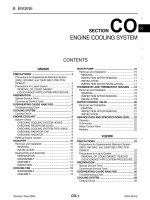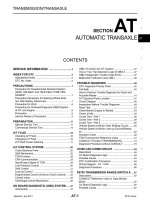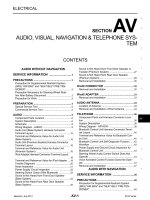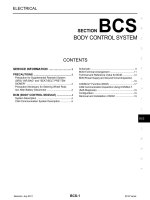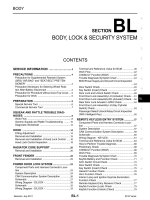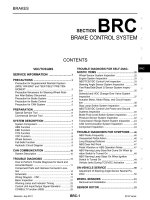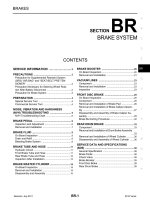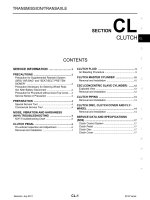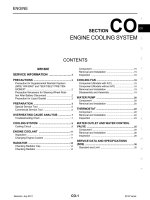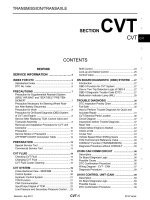CO hệ THỐNG làm mát NISSAN VERSA HATCH BACK 2012
Bạn đang xem bản rút gọn của tài liệu. Xem và tải ngay bản đầy đủ của tài liệu tại đây (1.54 MB, 30 trang )
CO-1
ENGINE
C
D
E
F
G
H
I
J
K
L
M
SECTION CO
A
CO
N
O
P
CONTENTS
ENGINE COOLING SYSTEM
MR18DE
SERVICE INFORMATION
2
PRECAUTIONS 2
Precaution for Supplemental Restraint System
(SRS) "AIR BAG" and "SEAT BELT PRE-TEN-
SIONER"
2
Precaution Necessary for Steering Wheel Rota-
tion After Battery Disconnect
2
Precaution for Liquid Gasket 3
PREPARATION 5
Special Service Tool 5
Commercial Service Tool 5
OVERHEATING CAUSE ANALYSIS 7
Troubleshooting Chart 7
COOLING SYSTEM 9
Cooling Circuit 9
ENGINE COOLANT 11
Inspection 11
Changing Engine Coolant 11
RADIATOR 14
Checking Radiator Cap 14
Checking Radiator 14
Component 15
Removal and Installation 15
Inspection 16
COOLING FAN 18
Component (Models with A/C) 18
Component (Models without A/C) 18
Removal and Installation 19
Disassembly and Assembly 19
WATER PUMP 20
Component 20
Removal and Installation 20
THERMOSTAT 22
Component 22
Removal and Installation 22
Inspection 23
WATER OUTLET AND WATER CONTROL
VALVE
25
Component 25
Removal and Installation 26
Inspection 28
SERVICE DATA AND SPECIFICATIONS
(SDS)
30
Standard and Limit 30
Revision: July 2011 2012 Versa
CO-2
< SERVICE INFORMATION >
[MR18DE]
PRECAUTIONS
SERVICE INFORMATION
PRECAUTIONS
Precaution for Supplemental Restraint System (SRS) "AIR BAG" and "SEAT BELT
PRE-TENSIONER"
INFOID:0000000007332013
The Supplemental Restraint System such as “AIR BAG” and “SEAT BELT PRE-TENSIONER”, used along
with a front seat belt, helps to reduce the risk or severity of injury to the driver and front passenger for certain
types of collision. This system includes seat belt switch inputs and dual stage front air bag modules. The SRS
system uses the seat belt switches to determine the front air bag deployment, and may only deploy one front
air bag, depending on the severity of a collision and whether the front occupants are belted or unbelted.
Information necessary to service the system safely is included in the SRS and SB section of this Service Man-
ual.
WARNING:
• To avoid rendering the SRS inoperative, which could increase the risk of personal injury or death in
the event of a collision which would result in air bag inflation, all maintenance must be performed by
an authorized NISSAN/INFINITI dealer.
• Improper maintenance, including incorrect removal and installation of the SRS can lead to personal
injury caused by unintentional activation of the system. For removal of Spiral Cable and Air Bag
Module, see the SRS section.
• Do not use electrical test equipment on any circuit related to the SRS unless instructed to in this
Service Manual. SRS wiring harnesses can be identified by yellow and/or orange harnesses or har-
ness connectors.
PRECAUTIONS WHEN USING POWER TOOLS (AIR OR ELECTRIC) AND HAMMERS
WARNING:
• When working near the Airbag Diagnosis Sensor Unit or other Airbag System sensors with the Igni-
tion ON or engine running, DO NOT use air or electric power tools or strike near the sensor(s) with a
hammer. Heavy vibration could activate the sensor(s) and deploy the air bag(s), possibly causing
serious injury.
• When using air or electric power tools or hammers, always switch the Ignition OFF, disconnect the
battery, and wait at least 3 minutes before performing any service.
Precaution Necessary for Steering Wheel Rotation After Battery Disconnect
INFOID:0000000007332014
NOTE:
• This Procedure is applied only to models with Intelligent Key system and NATS (NISSAN ANTI-THEFT SYS-
TEM).
• Remove and install all control units after disconnecting both battery cables with the ignition knob in the
″LOCK″ position.
• Always use CONSULT to perform self-diagnosis as a part of each function inspection after finishing work. If
DTC is detected, perform trouble diagnosis according to self-diagnostic results.
For models equipped with the Intelligent Key system and NATS, an electrically controlled steering lock mech-
anism is adopted on the key cylinder.
For this reason, if the battery is disconnected or if the battery is discharged, the steering wheel will lock and
steering wheel rotation will become impossible.
If steering wheel rotation is required when battery power is interrupted, follow the procedure below before
starting the repair operation.
OPERATION PROCEDURE
1. Connect both battery cables.
NOTE:
Supply power using jumper cables if battery is discharged.
2. Use the Intelligent Key or mechanical key to turn the ignition switch to the ″ACC″ position. At this time, the
steering lock will be released.
3. Disconnect both battery cables. The steering lock will remain released and the steering wheel can be
rotated.
4. Perform the necessary repair operation.
Revision: July 2011 2012 Versa
PRECAUTIONS
CO-3
< SERVICE INFORMATION >
[MR18DE]
C
D
E
F
G
H
I
J
K
L
M
A
CO
N
P
O
5. When the repair work is completed, return the ignition switch to the ″LOCK″ position before connecting
the battery cables. (At this time, the steering lock mechanism will engage.)
6. Perform a self-diagnosis check of all control units using CONSULT.
Precaution for Liquid Gasket INFOID:0000000007332015
REMOVAL OF LIQUID GASKET
• After removing nuts and bolts, separate the mating surface, using Tool and remove old liquid gasket.
CAUTION:
Be careful not to damage the mating surfaces.
• Tap Tool to insert it (1), and then slide it by tapping on the side (2)
as shown.
• In areas where Tool is difficult to use, use plastic hammer to lightly
tap the parts, to remove it.
CAUTION:
Do not damage the mating surfaces.
LIQUID GASKET APPLICATION PROCEDURE
1. Remove old liquid gasket adhering to the liquid gasket applica-
tion surface and the mating surface, using scraper.
• Remove liquid gasket completely from the groove of the liquid
gasket application surface, bolts, and bolt holes.
2. Thoroughly clean the mating surfaces and remove adhering
moisture, grease and foreign materials.
3. Attach liquid gasket tube to Tool.
Use Genuine RTV Silicone Sealant or equivalent. Refer to GI-42, "
Recommended Chemical Prod-
uct and Sealant".
4. Apply liquid gasket without breaks to the specified location with the specified dimensions.
• If there is a groove for the liquid gasket application, apply liquid gasket to the groove.
Tool number : KV10111100 (J-37228)
WBIA0566E
Tool number : WS39930000 ( — )
PBIC0003E
WBIA0567E
Revision: July 2011 2012 Versa
CO-4
< SERVICE INFORMATION >
[MR18DE]
PRECAUTIONS
• Apply the liquid gasket to the inner side of the bolt holes
unless the procedure instructions indicate to apply to the outer
side of the bolt holes.
• Install the mating component within five minutes of the liquid
gasket application.
• Then allow 30 minutes for the liquid gasket to set before filling
the engine with oil or coolant.
• If liquid gasket protrudes, wipe it off immediately.
• Do not retighten nuts or bolts after the five minutes have
elapsed.
CAUTION:
Carefully follow all of the warnings, cautions, notes, and proce-
dures contained in this manual.
SEM159F
Revision: July 2011 2012 Versa
PREPARATION
CO-5
< SERVICE INFORMATION >
[MR18DE]
C
D
E
F
G
H
I
J
K
L
M
A
CO
N
P
O
PREPARATION
Special Service Tool INFOID:0000000007332016
The actual shapes of Kent-Moore tools may from those of special service tools illustrated here.
Commercial Service Tool INFOID:0000000007332017
Tool number
(Kent-Moore No.)
Tool name
Description
KV991J0070
(J-45695)
Coolant Refill Tool
Refilling engine cooling system
EG17650301
(J-33984-A)
Radiator cap tester adapter
Adapting radiator cap tester to radiator cap
and radiator filler neck
a: 28 (1.10) dia.
b: 31.4 (1.236) dia.
c: 41.3 (1.626) dia.
Unit: mm (in)
KV10111100
(J-37228)
Seal cutter
Removing chain tensioner cover and water
pump cover
—
(J-23688)
Engine coolant refractometer
Checking concentration of ethylene glycol in
engine coolant
LMA053
S-NT564
NT046
WBIA0539E
Revision: July 2011 2012 Versa
CO-6
< SERVICE INFORMATION >
[MR18DE]
PREPARATION
Tool name Description
WS39930000
(—)
Tube presser
Pressing the tube of liquid gasket
Power tool Loosening bolts and nuts
Radiator cap tester Checking radiator and radiator cap
S-NT052
PBIC0190E
PBIC1982E
Revision: July 2011 2012 Versa
OVERHEATING CAUSE ANALYSIS
CO-7
< SERVICE INFORMATION >
[MR18DE]
C
D
E
F
G
H
I
J
K
L
M
A
CO
N
P
O
OVERHEATING CAUSE ANALYSIS
Troubleshooting Chart INFOID:0000000007332018
Symptom Check items
Cooling sys-
tem parts
malfunction
Poor heat transfer
Water pump malfunction Worn or loose drive belt
—
Thermostat stuck closed Thermostat
Damaged fins
Dust contamination or pa-
per clogging
Physical damage
Clogged radiator cooling
tube
Excess foreign material
(rust, dirt, sand, etc.)
Reduced air flow
Cooling fan does not oper-
ate
Fan assembly
—High resistance to fan rota-
tion
Damaged fan blades
Damaged radiator shroud — —
Improper engine coolant
mixture ratio
—
Engine coolant viscosity
—
Poor engine coolant quality — —
Insufficient engine coolant
Engine coolant leaks
Cooling hose
Loose clamp
Cracked hose
Water pump Poor sealing
Radiator cap
Loose
Poor sealing
Radiator
O-ring for damage, deterio-
ration or improper fitting
Cracked radiator tank
Cracked radiator core
Reservoir tank Cracked reservoir tank
Overflowing reservoir tank
Exhaust gas leaks into cool-
ing system
Cylinder head deterioration
Cylinder head gasket deteri-
oration
Revision: July 2011 2012 Versa
CO-8
< SERVICE INFORMATION >
[MR18DE]
OVERHEATING CAUSE ANALYSIS
Except cool-
ing system
parts mal-
function
— Overload on engine
Abusive driving
High engine rpm under no
load
Driving in low gear for ex-
tended time
Driving at extremely high
speed
Power train system mal-
function
—
Installed improper size
wheels and tires
Dragging brakes
Improper ignition timing
Blocked or restricted air
flow
Blocked bumper Installed front bumper fas-
cia cover
—
Blocked radiator grille Mud contamination or paper
clogging
Blocked radiator
Blocked air flowBlocked condenser
Installed large fog lamp
Symptom Check items
Revision: July 2011 2012 Versa
COOLING SYSTEM
CO-9
< SERVICE INFORMATION >
[MR18DE]
C
D
E
F
G
H
I
J
K
L
M
A
CO
N
P
O
COOLING SYSTEM
Cooling Circuit INFOID:0000000007332019
A/T MODELS
PBIC4719E
Revision: July 2011 2012 Versa
CO-10
< SERVICE INFORMATION >
[MR18DE]
COOLING SYSTEM
CVT MODELS
AWBIA0963GB
Revision: July 2011 2012 Versa
ENGINE COOLANT
CO-11
< SERVICE INFORMATION >
[MR18DE]
C
D
E
F
G
H
I
J
K
L
M
A
CO
N
P
O
ENGINE COOLANT
Inspection INFOID:0000000007332020
LEVEL CHECK
• Check that the reservoir tank level is within the “MIN” to “MAX”
range when engine is cool.
• Adjust the engine coolant level as necessary.
CHECKING COOLING SYSTEM FOR LEAKS
To check for leaks, apply pressure to the cooling system using suit-
able tool and Tool.
WARNING:
Never remove the radiator cap when the engine is hot. Serious
burns could occur from high pressure coolant escaping from
the radiator.
CAUTION:
Higher pressure than specified may cause radiator damage.
Changing Engine Coolant INFOID:0000000007332021
WARNING:
• To avoid being scalded, do not change engine coolant when engine is hot.
• Wrap a thick cloth around radiator cap and carefully remove the cap. First, turn the cap a quarter of a
turn to release built-up pressure. Then turn the cap all the way.
CAUTION:
• Do not spill engine coolant on drive belt.
DRAINING ENGINE COOLANT
1. Open radiator drain plug (1) at the bottom of radiator, and then
remove radiator cap.
• Front
When draining all of engine coolant in the system, open
water drain plug on cylinder block. Refer to EM-84
.
CAUTION:
• Perform this step when engine is cold.
• Do not spill engine coolant on drive belt.
2. Remove reservoir tank as necessary. Clean reservoir tank before installing. Refer to CO-15, "
Compo-
nent".
3. Check drained engine coolant for contaminants such as rust, corrosion or discoloration.
If contaminated, flush the engine cooling system.
SMA412B
Tool number : EG17650301 (J-33984-A)
Testing pressure
: 157 kPa (1.6 kg/cm
2
, 23 psi)
WBIA0568E
PBIC3799E
Revision: July 2011 2012 Versa
CO-12
< SERVICE INFORMATION >
[MR18DE]
ENGINE COOLANT
REFILLING ENGINE COOLANT
1. Install the radiator drain plug. Install the reservoir tank and cylinder block drain plug, (if removed).
• The radiator must be completely empty of coolant and water.
• Apply sealant to the threads of the cylinder block drain plugs. Use Genuine High Performance
Thread Sealant or equivalent. Refer to GI-42, "
Recommended Chemical Product and Sealant".
2. Reconnect the upper radiator hose, if disconnected.
3. Set the vehicle heater controls to the full HOT and heater ON position. Turn the vehicle ignition ON with
the engine OFF as necessary to activate the heater mode.
4. Install the Tool by installing the radiator cap adapter onto the
radiator neck opening. Then attach the gauge body assembly
with the refill tube and the venturi assembly to the radiator cap
adapter.
5. Insert the refill hose into the coolant mixture container that is
placed at floor level. Make sure the ball valve is in the closed
position.
• Use recommended coolant or equivalent.
Refer to MA-13, "
Fluids and Lubricants".
6. Install an air hose to the venturi assembly, the air pressure must
be within specification.
CAUTION:
The compressed air supply must be equipped with an air
dryer.
7. The vacuum gauge will begin to rise and there will be an audible hissing noise. During this process open
the ball valve on the refill hose slightly. Coolant will be visible rising in the refill hose. Once the refill hose is
full of coolant, close the ball valve. This will purge any air trapped in the refill hose.
8. Continue to draw the vacuum until the gauge reaches 28 inches
of vacuum. The gauge may not reach 28 inches in high altitude
locations, use the vacuum specifications based on the altitude
above sea level.
9. When the vacuum gauge has reached the specified amount, disconnect the air hose and wait 20 seconds
to see if the system loses any vacuum. If the vacuum level drops, perform any necessary repairs to the
system and repeat steps 6 - 8 to bring the vacuum to the specified amount. Recheck for any leaks.
10. Place the coolant container (with the refill hose inserted) at the same level as the top of the radiator. Then
open the ball valve on the refill hose so the coolant will be drawn up to fill the cooling system. The cooling
system is full when the vacuum gauge reads zero.
Radiator drain plug : Refer to CO-15, "
Component".
Cylinder block drain plug : 9.8 N·m (1.0 kg-m, 87 in-lb)
Tool number : KV991J0070 (J-45695)
Engine coolant capacity
(with reservoir tank)
: Refer to MA-13, "
Fluids
and Lubricants".
Compressed air
supply pressure
: 549 - 824 kPa (5.6 - 8.4 kg/cm
2
,
80 - 119 psi)
LLIA0058E
Altitude above sea level Vacuum gauge reading
0 - 100 m (328 ft) : 28 inches of vacuum
300 m (984 ft) : 27 inches of vacuum
500 m (1,641 ft) : 26 inches of vacuum
1,000 m (3,281 ft) : 24 - 25 inches of vacuum
LLIA0057E
Revision: July 2011 2012 Versa
ENGINE COOLANT
CO-13
< SERVICE INFORMATION >
[MR18DE]
C
D
E
F
G
H
I
J
K
L
M
A
CO
N
P
O
CAUTION:
Do not allow the coolant container to get too low when filling, to avoid air from being drawn into
the cooling system.
11. Remove the Tool from the radiator neck opening.
12. Fill the cooling system reservoir tank to the specified level and install the radiator cap. Run the engine to
warm up the cooling system and top up the system as necessary.
FLUSHING COOLING SYSTEM
1. Install reservoir tank if removed. Refer to CO-15, "Component".
2. Install radiator drain plug.
• Install the water drain plug on cylinder block if removed. Refer to EM-84, "
Disassembly and
Assembly".
CAUTION:
• Be sure to clean radiator drain plug and use a new O-ring. Refer to CO-15, "
Component".
• Do not reuse O-ring.
3. Fill radiator and reservoir tank with water and reinstall radiator cap.
4. Run engine and warm it up to normal operating temperature.
5. Rev engine two or three times under no-load.
6. Stop engine and wait until it cools down.
7. Drain water from the cooling system.
8. Repeat steps 1 through 7 until clear water begins to drain from radiator.
Revision: July 2011 2012 Versa
CO-14
< SERVICE INFORMATION >
[MR18DE]
RADIATOR
RADIATOR
Checking Radiator Cap INFOID:0000000007332022
• Check valve seat of radiator cap.
- Check if valve seat is swollen to the extent that the edge of the
plunger cannot be seen when watching it vertically from the top.
- Check if valve seat has no soil and damage.
• Pull negative-pressure valve to open it, and make sure that it is
completely closed when released.
- Make sure that there is no dirt or damage on the valve seat of radi-
ator cap negative-pressure valve.
- Make sure that the valve operates properly in the opening and
closing conditions.
• Check radiator cap relief pressure using suitable tool and Tool.
- When connecting the radiator cap to the tester, apply water or
coolant to the cap seal surface.
- Replace the radiator cap if there is an abnormality in the negative-
pressure valve, or if the open-valve pressure is outside of the stan-
dard values.
• Replace radiator cap if it is not within specifications.
CAUTION:
When installing radiator cap, thoroughly wipe out the radiator filler neck to remove any waxy residue
or foreign material.
Checking Radiator INFOID:0000000007332023
Check radiator for mud or clogging. If necessary, clean radiator as follows.
CAUTION:
• Be careful not to bend or damage radiator fins.
• When the radiator is cleaned on-vehicle, remove the surrounding parts in order to access the radia-
tor core.
• Then tape the harness and electrical connectors to prevent water from entering.
1. Spray water to the back side of the radiator core using a side-to-side motion from the top down.
2. Stop spraying when debris no longer flows from radiator core.
3. Blow air into the back side of radiator core using a side-to-side motion from the top down.
• Use compressed air lower than 490 kPa (5 kg/cm
2
, 71 psi) and keep distance more than 30 cm (11.81
in).
PBIC2816E
SMA967B
Tool number : EG17650301 (J-33984-A)
Standard: 78 – 98 kPa (0.8 – 1.0 kg/cm
2
, 11 – 14 psi)
Limit: 59 kPa (0.6 kg/cm
2
, 9 psi)
WBIA0570E
Revision: July 2011 2012 Versa
RADIATOR
CO-15
< SERVICE INFORMATION >
[MR18DE]
C
D
E
F
G
H
I
J
K
L
M
A
CO
N
P
O
4. Continue to blow air until no water sprays out.
5. Check for coolant leaks. Repair as necessary.
Component INFOID:0000000007332024
Removal and Installation INFOID:0000000007332025
WARNING:
1. Reservoir tank cap 2. Reservoir tank 3. Radiator hose (upper)
4. Mounting rubber (upper) 5. Radiator cap 6. Reservoir tank hose
7. Radiator 8. A/T fluid cooler hose 9. Mounting rubber (lower)
10. O-ring 11. Radiator drain plug 12. A/T fluid cooler hose
13. Radiator hose (lower) 14. Cooling fan assembly A. To water outlet
B. To A/T C. To water inlet D. M/T models
E. Models with A/C
AWBIA0961ZZ
Revision: July 2011 2012 Versa
CO-16
< SERVICE INFORMATION >
[MR18DE]
RADIATOR
Do not remove radiator cap when the engine is hot. Serious burns could occur from high-pressure
engine coolant escaping from radiator. Wrap a thick cloth around the cap. Slowly turn it a quarter of a
turn to release built-up pressure. Carefully remove radiator cap by turning it all the way.
NOTE:
When removing components such as hoses, tubes/lines, etc., cap or plug openings to prevent fluid from spill-
ing.
REMOVAL
1. Remove engine undercover. Refer to EI-15, "Removal and Installation".
2. Drain engine coolant from radiator. Refer to CO-11, "
Changing Engine Coolant".
CAUTION:
• Perform this step when engine is cold.
• Do not spill engine coolant on drive belt.
3. Remove air duct (inlet). Refer to EM-16
.
4. Remove reservoir tank as follows:
a. Disconnect reservoir tank hose.
b. Release the tab (A) in the direction shown by the arrow ( ).
c. Lift up while removing the reservoir tank hose, and remove it.
5. Disconnect harness connector from fan motor, and move harness aside.
6. Disconnect CVT or A/T fluid cooler hoses if equipped.
• Install plug to avoid leakage of CVT or A/T fluid, (if equipped).
7. Remove radiator hoses (upper and lower).
8. Remove radiator core support cover. Refer to BL-20
.
9. Remove cooling fan assembly.
10. Remove radiator core support (upper) bolts, bolts of stationary
part on the radiator core support side and clip. Lift radiator from
radiator (upper) mount part of radiator core support (upper) (2).
11. Move radiator assembly (1) to the rearward direction of vehicle,
and then lift it upward to remove.
CAUTION:
When removing do not damage or scratch radiator core or
A/C condenser (if equipped).
INSTALLATION
Installation is in the reverse order of removal.
CAUTION:
When removing do not damage or scratch radiator core or A/C condenser (if equipped).
Inspection INFOID:0000000007332026
INSPECTION AFTER INSTALLATION
• Before starting engine, check oil/fluid levels including engine coolant and engine oil. If less than required
quantity, fill to the specified level. Refer to MA-13, "
Fluids and Lubricants".
• Use procedure below to check for fuel leakage.
• Turn ignition switch ON (with engine stopped). With fuel pressure applied to fuel piping, check for fuel leak-
age at connection points.
PBIC3800E
PBIC3805E
Revision: July 2011 2012 Versa
RADIATOR
CO-17
< SERVICE INFORMATION >
[MR18DE]
C
D
E
F
G
H
I
J
K
L
M
A
CO
N
P
O
• Start engine. With engine speed increased, check again for fuel leakage at connection points.
• Run engine to check for unusual noise and vibration.
• Warm up engine thoroughly to make sure there is no leakage of fuel, exhaust gas, or any oils/fluids including
engine oil and engine coolant.
• Bleed air from passages in lines and hoses, such as in cooling system.
• After cooling down engine, again check oil/fluid levels including engine oil and engine coolant. Refill to spec-
ified level, if necessary.
• Summary of the inspection items:
*Power steering fluid, brake fluid, etc.
Item Before starting engine Engine running After engine stopped
Engine coolant Level Leakage Level
Engine oil Level Leakage Level
Transmission/
transaxle fluid
A/T and CVT Models Leakage Level/Leakage Leakage
M/T Models Level/Leakage Leakage Level/Leakage
Other oils and fluids* Level Leakage Level
Fuel Leakage Leakage Leakage
Exhaust gas — Leakage —
Revision: July 2011 2012 Versa
CO-18
< SERVICE INFORMATION >
[MR18DE]
COOLING FAN
COOLING FAN
Component (Models with A/C) INFOID:0000000007332027
Component (Models without A/C) INFOID:0000000007332028
1. Fan motor cover 2. Fan motor 3. Cooling fan control module
4. Washer 5. Fan shroud 6. Washer
7. Cooling fan A. Apply on fan motor shaft Front
PBIC4538E
1. Fan motor 2. Fan shroud 3. Cooling fan
A. Apply on fan motor shaft Front
WBIA0786E
Revision: July 2011 2012 Versa
COOLING FAN
CO-19
< SERVICE INFORMATION >
[MR18DE]
C
D
E
F
G
H
I
J
K
L
M
A
CO
N
P
O
Removal and Installation INFOID:0000000007332029
REMOVAL
CAUTION:
Never remove the radiator cap when the engine is hot. Serious burns could occur from high-pressure
engine coolant escaping from the radiator. Wrap a thick cloth around the radiator cap. Slowly turn it a
quarter of a turn to release built-up pressure. Carefully remove radiator cap by turning it all the way.
NOTE:
When removing components such as hoses, tubes/lines, etc., cap or plug openings to prevent fluid from spill-
ing.
1. Partially drain engine coolant from radiator. Refer to CO-11, "
Changing Engine Coolant".
CAUTION:
• Perform this step when engine is cold.
• Do not spill engine coolant on drive belt.
2. Remove air duct (inlet). Refer to EM-16, "
Component".
3. Remove reservoir tank. Refer to CO-15, "
Component".
4. Disconnect radiator hose (upper) at radiator side. Refer to CO-15, "
Component".
5. Disconnect harness connectors from fan motor, and move harness aside.
6. Remove cooling fan assembly.
CAUTION:
When removing do not damage or scratch radiator core or A/C condenser (if equipped).
INSTALLATION
Installation is in the reverse order of removal.
• Cooling fans are controlled by ECM. For details, refer to EC-407, "
On Board Diagnosis Logic".
CAUTION:
When installing do not damage or scratch radiator core or A/C condenser (if equipped).
Disassembly and Assembly INFOID:0000000007332030
DISASSEMBLY
1. Remove cooling fan from fan motor.
2. Remove fan motor from fan shroud.
INSPECTION AFTER DISASSEMBLY
Inspect cooling fan for cracks or warps.
• Replace cooling fan as necessary.
ASSEMBLY
Assembly is in the reverse order of disassembly.
Revision: July 2011 2012 Versa
CO-20
< SERVICE INFORMATION >
[MR18DE]
WATER PUMP
WATER PUMP
Component INFOID:0000000007332031
Removal and Installation INFOID:0000000007332032
WARNING:
Never remove the radiator cap when the engine is hot. Serious burns could occur from high-pressure
engine coolant escaping from the radiator. Wrap a thick cloth around the radiator cap. Slowly turn it a
quarter of a turn to release built-up pressure. Carefully remove radiator cap by turning it all the way.
NOTE:
When removing components such as hoses, tubes/lines, etc., cap or plug openings to prevent fluid from spill-
ing.
REMOVAL
1. Disconnect battery negative terminal. Refer to SC-7, "Removal and Installation".
2. Remove reservoir tank. Refer to CO-15, "
Component".
3. Drain engine coolant from radiator. Refer to CO-11, "
Changing Engine Coolant".
CAUTION:
Perform this step when the engine is cold.
4. Remove front fender protector (RH). Refer to EI-24, "
Removal and Installation".
5. Remove drive belt. Refer to EM-13, "
Removal and Installation".
6. Remove generator. Refer to SC-25, "
Removal and Installation".
7. Remove radiator hose (lower). Refer to CO-15, "
Component".
8. Remove water pump.
CAUTION:
• Handle water pump vane so that it does not contact any other parts.
• Water pump cannot be disassembled and must be replaced as a unit.
INSPECTION AFTER REMOVAL
1. Gasket 2. Water pump
PBIC3921E
Revision: July 2011 2012 Versa
WATER PUMP
CO-21
< SERVICE INFORMATION >
[MR18DE]
C
D
E
F
G
H
I
J
K
L
M
A
CO
N
P
O
• Visually check for significant dirt or rust on the water pump body
and vane (A).
• Check that the vane shaft turns smoothly by hand and is not
excessively loose.
• Replace the water pump assembly if the water pump does not per-
form properly.
INSTALLATION
Installation is in the reverse order of removal.
INSPECTION AFTER INSTALLATION
• Check that the reservoir tank cap is tightened.
• Check for engine coolant leaks. Refer to CO-11, "
Inspection".
• Start and warm up the engine.
• Visually check for engine coolant leaks.
PBIC3313J
Revision: July 2011 2012 Versa
CO-22
< SERVICE INFORMATION >
[MR18DE]
THERMOSTAT
THERMOSTAT
Component INFOID:0000000007332033
Removal and Installation INFOID:0000000007332034
REMOVAL
WARNING:
Never remove the radiator cap when the engine is hot. Serious burns could occur from high-pressure
engine coolant escaping from the radiator. Wrap a thick cloth around the radiator cap. Slowly turn it a
quarter of a turn to release built-up pressure. Carefully remove radiator cap by turning it all the way.
NOTE:
When removing components such as hoses, tubes/lines, etc., cap or plug openings to prevent fluid from spill-
ing.
1. Drain engine coolant from radiator. Refer to CO-11, "
Changing Engine Coolant".
CAUTION:
• Perform this step when engine is cold.
• Never spill engine coolant on drive belt.
2. Remove the air duct (inlet). Refer to EM-16, "
Component".
3. Remove the radiator hose (lower) from the engine. Refer to CO-15, "
Component".
4. Remove water inlet.
5. Remove thermostat.
6. Remove water pump, if necessary. Refer to CO-20
.
7. Remove thermostat housing, if necessary.
INSPECTION AFTER REMOVAL
1. Gasket 2. Thermostat housing 3. Clamp
4. Water hose 5. O-ring 6. Thermostat
7. Water inlet 8. Clamp 9. Radiator hose (lower)
A. CVT models B. To CVT fluid warmer C. To radiator
JPBIA2884GB
Revision: July 2011 2012 Versa
THERMOSTAT
CO-23
< SERVICE INFORMATION >
[MR18DE]
C
D
E
F
G
H
I
J
K
L
M
A
CO
N
P
O
• Place a thread (A) so that it is caught in the valves of thermostat
(1). Immerse fully in a container (B) filled with water. Heat while
stirring.
• The valve opening temperature is the temperature at which the
valve opens and falls from the thread.
• Continue heating. Check the full-open valve lift amount.
• After checking the full-open valve lift amount, lower the water tem-
perature and check the valve closing temperature.
• Replace thermostat if it is out of the specification range.
INSTALLATION
Installation is in the reverse order of removal.
• Use the following procedure to install the thermostat.
- Install thermostat making sure O-ring (1) groove fits securely to
thermostat flange (A).
CAUTION:
Replace the O-ring with a new one.
- Install thermostat (1) into the thermostat housing (2) with jiggle
valve (A) facing upward.
• Use the following procedure to install the thermostat housing.
- Securely insert the O-ring into the mating groove of thermostat housing and install it.
CAUTION:
• Replace the O-ring with a new one.
• Do not reuse O-ring.
- Install the thermostat housing to the cylinder block without displacing the gasket from the gasket position.
Inspection INFOID:0000000007332035
INSPECTION AFTER INSTALLATION
• Before starting engine, check oil/fluid levels including engine coolant and engine oil. If less than required
quantity, fill to the specified level. Refer to MA-13, "
Fluids and Lubricants".
• Use procedure below to check for fuel leakage.
• Turn ignition switch ON (with engine stopped). With fuel pressure applied to fuel piping, check for fuel leak-
age at connection points.
• Start engine. With engine speed increased, check again for fuel leakage at connection points.
• Run engine to check for unusual noise and vibration.
• Warm up engine thoroughly to make sure there is no leakage of fuel, exhaust gas, or any oils/fluids including
engine oil and engine coolant.
• Bleed air from passages in lines and hoses, such as in cooling system.
Standard : Refer to CO-30, "
Standard and Limit"
PBIC3314J
PBIC3315J
PBIC3548J
Revision: July 2011 2012 Versa
CO-24
< SERVICE INFORMATION >
[MR18DE]
THERMOSTAT
• After cooling down engine, again check oil/fluid levels including engine oil and engine coolant. Refill to spec-
ified level, if necessary.
• Summary of the inspection items:
*Power steering fluid, brake fluid, etc.
Item Before starting engine Engine running After engine stopped
Engine coolant Level Leakage Level
Engine oil Level Leakage Level
Transmission/
transaxle fluid
A/T and CVT Models Leakage Level/Leakage Leakage
M/T Models Level/Leakage Leakage Level/Leakage
Other oils and fluids* Level Leakage Level
Fuel Leakage Leakage Leakage
Exhaust gas — Leakage —
Revision: July 2011 2012 Versa
WATER OUTLET AND WATER CONTROL VALVE
CO-25
< SERVICE INFORMATION >
[MR18DE]
C
D
E
F
G
H
I
J
K
L
M
A
CO
N
P
O
WATER OUTLET AND WATER CONTROL VALVE
Component INFOID:0000000007332036
A/T and M/T MODELS
PBIC4699E
1. Engine coolant temperature sensor 2. O-ring 3. Water control valve
4. Gasket 5. Water hose 6. Gasket
7. Water hose 8. Water outlet 9. Heater hose
10. Heater hose 11. Radiator hose (upper) Front
A. To heater B. To electric throttle control actuator C. To radiator
Revision: July 2011 2012 Versa
